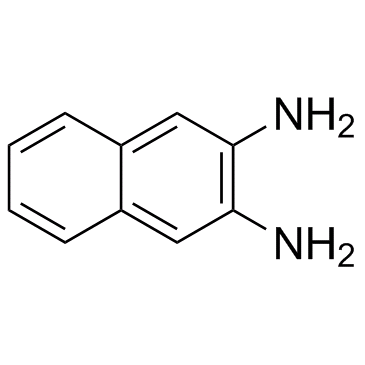2,3-Diaminonaphthalene

2,3-Diaminonaphthalene structure
|
Common Name | 2,3-Diaminonaphthalene | ||
|---|---|---|---|---|
| CAS Number | 771-97-1 | Molecular Weight | 158.200 | |
| Density | 1.2±0.1 g/cm3 | Boiling Point | 370.6±15.0 °C at 760 mmHg | |
| Molecular Formula | C10H10N2 | Melting Point | 197-203 °C | |
| MSDS | Chinese USA | Flash Point | 212.3±19.9 °C | |
| Symbol |

GHS07 |
Signal Word | Warning | |
|
Monocyte Traffic, Dorsal Root Ganglion Histopathology, and Loss of Intraepidermal Nerve Fiber Density in SIV Peripheral Neuropathy.
Am. J. Pathol. 185 , 1912-23, (2015) HIV-associated sensory neuropathy remains the most common neurological complication of HIV infection and is characterized by dorsal root ganglion (DRG) inflammation and intraepidermal nerve fiber density (IENFD) loss. Chronic peripheral immune cell activation... |
|
|
Flower-like Palladium Nanoclusters Decorated Graphene Electrodes for Ultrasensitive and Flexible Hydrogen Gas Sensing.
Sci. Rep. 5 , 12294, (2015) Flower-like palladium nanoclusters (FPNCs) are electrodeposited onto graphene electrode that are prepared by chemical vapor deposition (CVD). The CVD graphene layer is transferred onto a poly(ethylene naphthalate) (PEN) film to provide a mechanical stability ... |
|
|
Inhibition of invasion by glycogen synthase kinase-3 beta inhibitors through dysregulation of actin re-organisation via down-regulation of WAVE2
Biochem. Biophys. Res. Commun. 464 , 275-80, (2015) Cancer cell invasion is a critical phenomenon in cancer pathogenesis. Glycogen synthase kinase-3β (GSK-3β) has been reported to regulate cancer cell invasion both negatively and positively. Thus, the net effect of GSK-3β on invasion is unclear. In this report... |
|
|
Expression profiles of NPHP1 in the germ cells in the semen of men with male factor infertility.
Andrology 3 , 685-93, (2015) NPHP1, the gene that encodes the protein nephrocystin-1 has been identified to be mutated in Juvenile Nephronophthisis, an autosomal recessive cystic kidney disorder which is the most frequent genetic cause of end-stage renal disease (ESRD) in children and yo... |
|
|
Multiresidue determination of fluoroquinolones in poultry muscle and kidney according to the regulation 2002/657/EC. A systematic comparison of two different approaches: Liquid chromatography coupled to high-resolution mass spectrometry or tandem mass spectrometry.
J. Chromatogr. A. 1379 , 83-91, (2015) This work involved the optimization and validation of two methods according to the Commission Decision 2002/657/EC directives for determining fluoroquinolones residues in samples of poultry muscle and kidney: ciprofloxacin, danofloxacin, difloxacin, enrofloxa... |
|
|
Effects of fatty acyl chain length, double-bond number and matrix on phosphatidylcholine responses in matrix-assisted laser desorption/ionization on an Orbitrap mass spectrometer.
Rapid Commun. Mass Spectrom. 29 , 2374-84, (2015) Matrix-assisted laser desorption/ionization mass spectrometry (MALDI-MS) is used for the fast qualitative and quantitative analysis of phosphatidylcholines (PC). Fatty acyl chain lengths and the number of double bonds (DB) affect relative responses of PC; hen... |
|
|
A new strategy to determine the protein mutation site using matrix-assisted laser desorption ionization in-source decay: derivatization by ionic liquid.
Anal. Chim. Acta 865 , 31-8, (2015) Matrix-assisted laser desorption ionization (MALDI) time-of-flight mass spectrometry (TOF-MS) can be considered as state of the art in the field of proteins and peptides analysis. In this work, we have designed an ionic liquid derivative strategy to obtain ab... |
|
|
Subcellular-level resolution MALDI-MS imaging of maize leaf metabolites by MALDI-linear ion trap-Orbitrap mass spectrometer.
Anal. Bioanal. Chem 407(8) , 2301-9, (2015) A significant limiting factor in achieving high spatial resolution for matrix-assisted laser desorption ionization-mass spectrometry (MALDI-MS) imaging is the size of the laser spot at the sample surface. Here, we present modifications to the beam-delivery op... |
|
|
Simultaneous determination of 38 veterinary antibiotic residues in raw milk by UPLC-MS/MS.
Food Chem. 181 , 119-26, (2015) A selective and rapid method has been developed to determine, simultaneously, 38 veterinary antibiotic residues in raw milk by ultra-high-performance liquid chromatography-tandem mass spectrometry (UPLC-MS/MS). One milliliter of raw milk was diluted with 0.5 ... |
|
|
Monitoring therapeutic monoclonal antibodies in brain tumor.
MAbs 6(6) , 1385-93, (2014) Bevacizumab induces normalization of abnormal blood vessels, making them less leaky. By binding to vascular endothelial growth factor, it indirectly attacks the vascular tumor mass. The optimal delivery of targeted therapies including monoclonal antibodies or... |